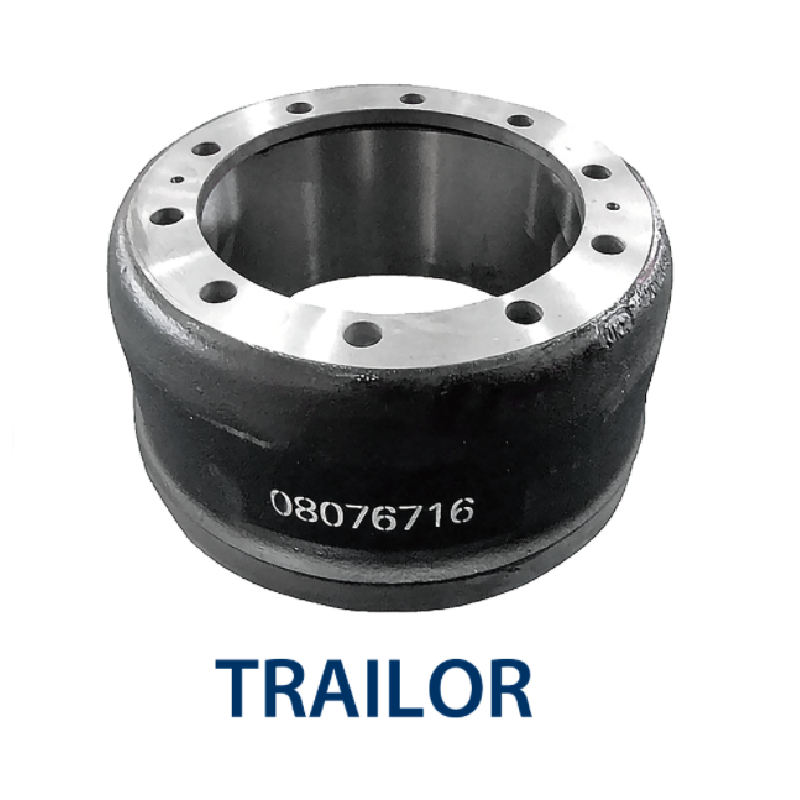Oct . 22, 2024 06:50 Back to list
Understanding the Benefits of Composite Brake Drums for Improved Performance and Safety
The Importance of Composite Brake Drums in Modern Vehicles
In the continually evolving landscape of automotive technology, the focus on safety, performance, and efficiency is paramount. One of the significant advancements in this realm is the development of composite brake drums. These innovative components are revolutionizing braking systems, offering numerous advantages over traditional cast iron or steel drums. This article delves into the composition, advantages, and applications of composite brake drums, highlighting their significance in contemporary vehicles.
Understanding Composite Brake Drums
Composite brake drums are made from a combination of materials, often incorporating fibers such as glass or carbon with resin matrices. This blended structure allows for unique properties that enhance the performance of the braking system. Unlike traditional materials that are heavy and prone to corrosion, composite materials are lighter and possess greater resistance to environmental factors.
The manufacturing process of composite brake drums involves carefully layering fibers within a resin, which is then cured to form a robust structure. This results in a product that not only meets the necessary engineering specifications but also exceeds performance expectations in various conditions.
Advantages of Composite Brake Drums
1. Weight Reduction One of the most significant benefits of composite brake drums is their lightweight nature. This reduction in weight enhances overall vehicle efficiency, allowing for improved fuel economy. A lighter brake drum translates to less energy needed for the vehicle to operate, ultimately contributing to lower emissions.
2. Enhanced Performance Composite materials provide better thermal management compared to traditional steel or cast iron drums. They dissipate heat more effectively, reducing the risk of brake fade during intense braking situations. The improved heat resistance leads to consistent braking performance, enhancing safety and driver confidence in various driving conditions.
3. Corrosion Resistance Traditional brake drums are susceptible to rust and corrosion, particularly in wet or humid environments. Composite brake drums, on the other hand, resist corrosion due to their non-metallic nature. This longevity translates into lower maintenance costs and extended service life, as vehicle owners do not need to replace these components as frequently.
composite brake drum

4. Better Friction Characteristics The friction materials used in conjunction with composite brake drums can be optimized for better performance. This compatibility ensures smoother engagement and disengagement during braking, resulting in a quieter and more efficient braking experience. Moreover, the ability to tailor friction characteristics can lead to improved stopping distances and reduced wear on both the brake drum and pads.
5. Environmental Impact In a world increasingly focused on sustainability, the use of composite materials offers an eco-friendly alternative to traditional brake components. The materials can often be sourced responsibly and may even be recyclable, lessening their overall environmental footprint.
Applications in Modern Vehicles
Composite brake drums are not just a theoretical advancement; they are increasingly being integrated into various vehicle models, particularly in high-performance and electric vehicles. The automotive industry is gradually recognizing the benefits of these materials, leading to wider adoption across mainstream vehicles as well.
Electric and hybrid vehicles, which face unique challenges regarding weight and braking efficiency, particularly benefit from the use of composite brake drums. As manufacturers strive for better energy efficiency and performance, the adoption of advanced materials like composites becomes vital.
Additionally, high-performance vehicles, which demand superior braking capabilities, have led to the design and implementation of composite brake drums to meet these rigorous standards. They cater to racing applications and performance-oriented consumer vehicles, where every fraction of weight savings and enhancement in braking performance can make a substantial difference.
Conclusion
As automotive technology advances, the integration of composite brake drums marks a significant step forward in enhancing vehicle safety, performance, and efficiency. With their lightweight design, superior thermal management, and resistance to corrosion, these innovative components are set to play a crucial role in the future of braking systems. The ongoing commitment to improving vehicle technology ensures that composite brake drums will become a standard feature in a wide range of vehicles, benefiting manufacturers, drivers, and the environment alike. As we move towards a more sustainable automotive future, embracing these advancements will be essential for both performance and ecological responsibility.
-
Scania Brake Drums: OEM Quality for Optimal Safety & Durability
NewsAug.16,2025
-
R.V.I: Advanced Remote Visual Inspection for Precision
NewsAug.15,2025
-
Discover HYUNDA: Innovative Vehicles, Equipment & Solutions
NewsAug.14,2025
-
R.V.I: Unlock Advanced Insights & Real-time Performance
NewsAug.13,2025
-
Kamaz Brake Drum: Durable & Reliable for Heavy Duty Trucks
NewsAug.12,2025
-
Heavy Duty Iveco Brake Drum - Premium Quality & Safety
NewsAug.11,2025
